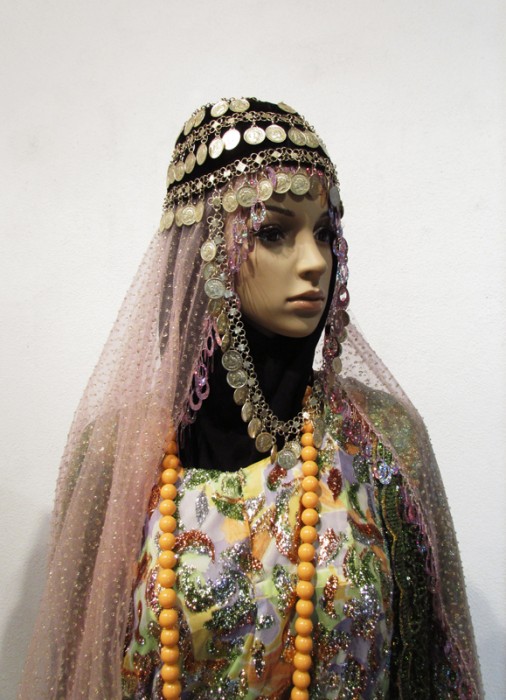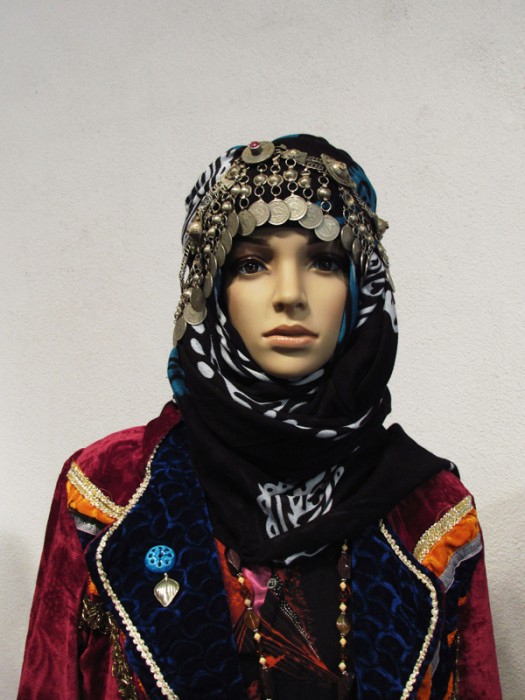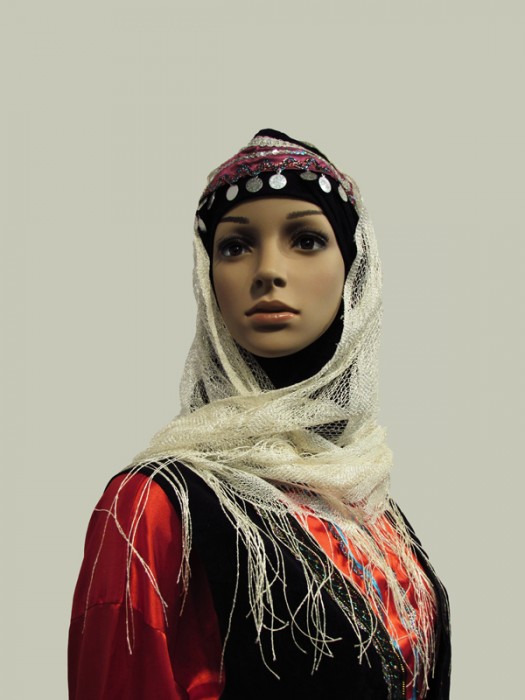Persian Costume
-
Prize
-
PhotographerMir Kian Roshannia, Iran
-
Studio-
-
Website
TRADITIONAL Iranian Dress---
Iran is a vast country containing many different ethnicities and
languages. As a result, the traditional dress tends to vary by region,
territory and sometimes even individual village. By in large, the majority
of the ethnicities pertaining to the regions of Iran, dictate the
traditional costumes. These include dress styles for Bakhtiaris, Baluchis,
Loris, Gilanis, Kurds, Ghoochanis, Ghashghahis, and others.-----
Image 1 :--- Hormozgan Clothing
women's clothing is usually a long dark dress with decorated pants. In almost all of the southern provinces of Iran women and girls wear a mask to protect their faces from the hot sun.
It is sometimes alleged that the face-veil was originally part of women's dress among certain classes in the Byzantine Empire and was adopted into Muslim culture during the Arab conquest of the Middle East. However, although Byzantine art before Islam commonly depicts women with veiled heads or covered hair, it does not depict women with veiled faces.
The Niqab was traditionally worn in Southern Iran from the arrival of Islam until the end of the Qajar era. There were many regional variations of NiqÃ?b, which were also called Ruband or Pushiye.
In modern Iran, the wearing of niqÃ?b is not common and is only worn by certain ethnic minorities and a minority of Arab Muslims in the southern iranian coastal cities, such as Bandar Abbas, Minab and Bushehr. Some women in the Arab-populated province of Khuzestan still wear niqab.
Image-2 ( Kurdish Kormanji Clothing) & Image-3 ( Kurdish Sorani Clothing) ----------------- By far the most elaborate and diverse form of traditional dress comes from the many Kurds who inhabit several regions of Iran. Since the Kurds live in different regions, their clothes also tend to vary.
Both men and women commonly have belts which are very wide and tightly wrapped around the waist over the clothes to give the outfit some shape. Shirts, skirts, and trousers for both men and women tend to be very baggy and over-sized. Kurdish women tend to wear many coins and jewels which dangle on their forehead and are attached to a scarf or shawl.
The traditional Kurdish dresses are for everyday wear and are not reserved only for holidays. The Kurdish costume was worn everyday in the past. Currently some women still wear them on a daily basis especially by the older generation of women. The dresses worn on a daily basis tend to be modest in colour and have little or no accessories or embroideries. In the present day the Kurdish dress is more commonly worn on special occasions.
Traditional Kurdish women's outfit includes either a vest or long-sleeved jacket or long overcoat worn over a gown. An under dress and puffy pants is worn beneath the gown. A belt over the gown is also needed. Traditionally women wore Kurdish hats ornamented with valued coloured stones, beads and gold pieces. Overtime this has become less common. Now it is more popular among women to only accessorise with gold Jewellery. Usually younger women and young girls wear brightly coloured dresses adorned with many beads and sequences and the older women wear darker colours. However older women tend to wear more gold jewellery because traditionally when women married they would receive a dowry of gold jewellery pieces from their groom, the tradition implied that the amount of gold pieces a woman wore signified the status amongst other women in their society. This still applies today to a lesser extent.
Kormanj tribe is one of the most important Kurdish ethnic groups currently living in northern parts of Khorasan province. These people first migrated to this area during Shah Abbas' time.
It was Shah Abbas who tricked these brave and patriotic people to migrate to this area.
Sorani (also called Kurdi) is a Kurdish language spoken mainly in Iraq and Iran, with an estimated 15 million speakers world-wide. The Kurds are spread across the countries of Iraq, Iran, Turkey, Syria, as well as Georgia, Armenia, Azerbaijan and Lebanon. There is also a large diaspora of Kurds, which is especially prominent in Europe.
Image-4: --------The dress of the people from Lorestan is very distinct and ornamental. The
Lori dress tends to have hand-sewn designs such as paisley and flowers on
the sleeve ends and rims of jackets and trousers. The head gear for the
Lori people is a rounded look and is achieved by wrapping a large scarf
not just on the head but all around the shoulders and neck as well. There
is then also an additional cloth that hangs down from the top of the head.
In this sample outfit we see the distinct decorations on the edges of the
clothes, including the traditional long vest, worn over the dress and
trousers. The vest has shorter sleeves, allowing for the dress sleeves to
come through. The trousers also have the trade mark stripe designs at the
hem. Women's outfits usually use brighter, more feminine colors such as
light green, blue, pink and red with flower or rainbow-like patterns.
Image-5: ------------Mazandarani dress
One of the most interesting traditional dresses is the Mazandarani dress.
The Mazandaran region lies to the north of Iran, in the area of the
Caspian Sea, north of Tehran. The region is filled with farmlands and
engages in agriculture. The costume of Mazandaran consists of trousers and
dress, like most regional dress. The distinguishing feature in the
Mazandarani dress, for women, is the skirt. It is usually much shorter and
much fuller than the usual traditional outfits. Depending on the occasion
and the time of year, the skirts can get quite short, and be likened to
puffy mini-skirts.
Born and raised in Tehran, graduate from dentistry and work as a dentist, interested in digital photography from 2004.
Studied at "Tehran Fine Art University" Faculty of photography as a freelance student for 1 year and work as freelance photographer with interest in Fine Art.
My conceptual work is a confluence of people, elements and landscape. After photographing these subjects, sometimes combine several natural images into one single image.
Awards PHOTOGRAPHY CREDENTIALS:
- FIAP Gold Medal Guller Ertan Turkey 2018
- IAAP Gold Medal Contrast Bosnia 2018
-Honorable Mention 6th Khayyam International Exhibition Of Photography Iran 2018
- Mull Gold Medal Contrast Bosnia 2017
- Gold Medal The 122th Toronto International Salon of Photography, Canada 2015
-Honorable Mention PX3 Prix De La Photographie Paris 2014
-Honorable Mention International Photography Award, USA 2013
-Gold Medal Tropical Image Int’l Exhibition, USA 2012
-FIAP Bronz Medal -14th International Photographic Art Exhibition- China 2011
-Gold Medal -Advertizing-Fashion PX3 Prix De La Photographie Paris France 2011
-Gold Medal -Press-Fashion PX3 Prix De La Photographie Paris France 2011
-Silver Medal -Press-Performing Arts PX3 Prix De La Photographie Paris France 2011
-1st Fine Art Category Winner People’s Choice Award PX3 Paris France 2011
-1st Fine Art Category Winner People’s Choice Award PX3 Paris France 2010
-2nd Place Fine Art Abstract PX3 Prix De La Photographie Paris France 2010
-Honorable Mention International Photography Award, USA 2010
-Honorable Mention PX3 Prix De La Photographie Paris 2009
-3rd Place Portraiture People’s Choice Award PX3 Paris 2009
-Honorable Mention International Photography Award, USA 2008
-Honorable Mention Tropical Image Int’l Exhibition, USA 2008
-Knack Photo Award Knokke, Belgium 2007




